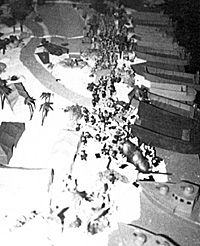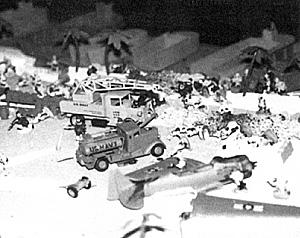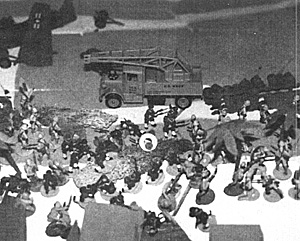 The battle for Wake Island will pit 130 United States
Marines against three waves of 220 Japanese troops each.
The Americans will be in prepared positions, and will gain
points for killing the enemy and for holding the airfield and
coastal defense guns.
The battle for Wake Island will pit 130 United States
Marines against three waves of 220 Japanese troops each.
The Americans will be in prepared positions, and will gain
points for killing the enemy and for holding the airfield and
coastal defense guns.
Each Japanese wave will have two 75 mm howitzers, and each 10-man Japanese squad will have one sub-machine gun and one man with a potentially deadly knee mortar.
While the Americans have no mortars or artillery, their heavy machine guns can easily sweep across the lagoon and the protected positions make it almost impossible for enemy riflemen to fire back successfully.
The Americans set up first. They are required to deploy on all three islands, but are not told that the Japanese are restricted to landing their first wave only on the south shore, repeating the historic Japanese invasion.
Morale for both sides is 18. The Japanese are given one Naval salvo of 105 mm shells. Scattered heavily across all three islands are dozens of small stands of brush, each adding two on the "to hit" rolls. (simulating the wide- spread brush which provided light cover across much of the island)
TURN ONE - 0600
The American troops awaken to see a seeminglysolid wall of Japanese landing craft on the southern beaches, from the western tip of Wilkes island to the eastern tip of Wake Island.
(We left history here and had the Japanese landing in the dark. Also knowing a landing was about to take place Marines would not be sleeping. Ed Note)
The swarming Japanese actually reach both the eastern and western coastal defense guns, with three or four troops actually getting over the sandbags.
But the maximum movement of the troops in the nearest of the landing craft is barely enough to let them get out of the small boats. And, on the first turn, they can not fire.
Five squads of Japanese have landed on Wilkes, and 12 have hit the beaches of Wake itself The invasion force at Wake is also backed by two 75 mm. guns, a heavy machine gun squad, and other supporting troops.
The American response is swift. Two trucks with Red Cross markings speed east from Peale and cross the bridge to Wake. A gasoline truck also begins moving slowly toward the advancing Japanese horde.
As they move, a salvo of artillery from the Japanese ships anchored off Wake comes crashing down, destroying a sand-bagged American heavy machine gun on Peale Island and killing its crew. another salvo lands on Wake, destroying another heavy machine gun) but two of the three crewmen escape serious injury.
Now its the American's turn. The Japanese troops are hit with a withering hail of gunfire. Sub-machine guns fired from defensive coastal gun positions each cut down a full squad, while heavy machine guns from the north also concentrate their fire on the troops attacking the valuable but vulnerable gun positions, taking out two more invasion squads. A heavy machine gun mounted on a jeep which had raced to the end of a pier on Peale Island fires across the water and takes out some additional invaders while riflemen hiding in the heavy brush on Peale and the northern end of Wake add to the carnage.
At the end of the turn, the Japanese have lost 40 to 70 men, including more than two of the five squads invading Wilkes. But, they have gained a solid foothold on Wake, reaching from the beach to the southern perimeter of the airfield. And, a machine gun has been set up behind a heavy bulldozer on Wilkes.
The positions make it virtually impossible for the Americans to ford the small channel and cross over to Wake in safety..
The Americans have lost eight men on Wake and six more on Wilkes, all workers who met the initial invasion forces in the brush on the island's shore and were overwhelmed in the initial rush to the beach.
 TURN TWO - 0630
TURN TWO - 0630
The Americans continue their swift response, pulling troops off Peale and shifting to set up a defense in depth on Wake. At the same time, they pull troops back from the overwhelming numbers of Japanese near the airfield, setting up five men and a heavy machine gun behind some tents at the western edge of the island.
The activity is met with several bursts of defensive fire, but of the nine men targeted, only three Americans are killed.
The American fuel truck continues heading toward the forward elements of the Japanese line, only to be riddled with sub-machine gun fire. The driver is killed and the truck crashes, exploding the volatile aviation fuel. Three Japanese soldiers on the front line die in the fiery explosion.
Still, the Japanese continue their swarming advance on Wake, crossing the southern road and getting onto the airfield and within grenade range of an anti-aircraft gun which has already taken its toll on the attackers.
Meanwhile, on Wilkes, the surviving Japanese medium machine gun fires suppression fire at the five men behind sandbags in the western coastal defense gun, allowing four knee mortars to be setup and fire at it. One lucky shot hits, destroying the gun and killing three of the five guards behind the sandbagged position.
The fighting on on Wake is highlighted by fire fights across the inlet. While the brush makes it difficult for riflemen to hit targets, an American machine gun kills the crew of one of the two Japanese 75 mm. field pieces. Revenge is swift, as the American machine gun crew is targeted and killed by a Japanese machine gun.
The surviving Japanese field artillery crew targets a lone house on the north side of the island, and begins to batter it to pieces. Americans have been firing from inside, but none are hurt.
 TURN THREE 0700
TURN THREE 0700
The Japanese troops now advance into the abandoned American positions on the south end of Wake, running into the foxholes and behind the other prepared positions that overlook the interior lagoon.
There is still fierce hand-to-hand combat taking place involving a little knot of surviving Americans on the very western tip of the island's southern edge, and riflemen exchange shots from the buildings at the center of Wake. A wooden structure, possibly an ammo dump, lies exposed just north of the American-occupied structures, and is destroyed by a morter round.
On Wilkes, the Japanese kill only two Americans with their mortars and machine guns, while their mounting casualties bring the invaders losses to about 70 per-cent. And, a bad morale roll means one of the two remaining squads can not advance in the next turn.
The total loss to the Japanese on both islands is about 60 per-cent of the entire invasion wave, but they have managed to meet their initial battle objectives, securing a solid beachhead on Wilkes and taking t e air eld at Wake, as well as destroying the coastal defense guns or killing the crew on the southern edge of the island. The American casualties total just under half their troops, but they are losing heavy machine guns and anti-aircraft guns at an alarming rate.
It is also becoming clear that the prepared coastal gun positions are a problem for both sides. Japanese infantry without automatic weapons can hit only by rolling ones, while the American defenders with submachine guns do not have the ability to fire far enough to protect themselves against the Japanese mortar crews.
On Wilkes, it seems to be leading to a stand-off. The The Japanese can attack the positions successfully only with hand grenades or in hand-to-hand combat. The sub- machine guns provide enough defensive fire so that the Japanese can not get close enough to do it.
TURN FOUR - 0730
There is only a minor adjustment by American infantry, which are beginning to be stretched thin on Wake. Less than a dozen soldiers remain on Wilkes, and none of them dare to leave their prepared positions.
While the hand-to-hand battle continues at the west end of the airfield, Japanese units continue setting up in the foxholes and sandbagged positions abandoned by the Americans, and begin to push forward toward the center of the island.
One brave American, a bulldozer operator, charges forward in his slowly lumbering machine, overrunning and killing one Japanese soldier who foolishly ran in front of it.
American automatic weapons fire kills two of the four mortar carriers on Wilkes, and 13 Japanese are killed on Wake, compared to seven American defenders. Most of the losses on both sides are caused by an exchange of long- range fire across the lagoon. Three Japanese hiding behind crates at the northern edge of the airfield are killed when the crates filled with ammunition are struck by machine gun fire and explode. By the end of the turn, the Japanese have lost about 75 per-cent of their initial invasion troops, while the americans have lost 59 figures, just under half of the 130 with which they began the battle.
TURN FIVE 0730
The second Japanese invasion wave arrives as scheduled, another 17 landing craft. But, this time, they land on the outside shore of all three islands.
Five more squads land at Wilkes, while three squads spread out on the beaches of nearly-defenseless Peale. And, eight mortar squads are spreading out on Wake, most of them behind the American defenders in their prepared positions in the center of the island.
There is little American movement in response. The bulldozer driver again attempts to run down individual Japanese soldiers, but is cut down by defensive fire from a light machine gun.
Mortar fire kills three Americans in a prepared position on Wilkes - the only shot to cause damage to them in four turns of fire.
American defensive fire again takes its toll on the invading Japanese, as the remaining automatic weapons find tempting concentrations of targets just off the boats.
A dozen of the newly-landed Japanese troops are killed on Wilkes - including half a squad that landed near the two remaining sub-machine gunners behind the sand bags of the western coastal defense gun. another 20 Japanese die on Wake.
But, it is too little. There are only a dozen Americans left on Peale, and 48 on Wake. Only two Americans remain alive on Wilkes, and both must face hand-to-hand combat against two and three Japanese each. It is a battle they will lose.
With a casualty rate of 63 per-cent and no hope, the Americans surrender.
Wake Island The Game
Back to Table of Contents -- Combat Simulation Vol 2 No. 3
Back to Combat Simulation List of Issues
Back to MagWeb Magazine List
© Copyright 1996 by Mike Vogell and Phoenix Military Simulations.
This article appears in MagWeb (Magazine Web) on the Internet World Wide Web.
Other articles from military history and related magazines are available at http://www.magweb.com
